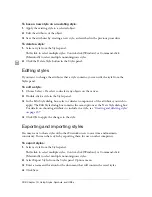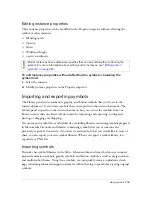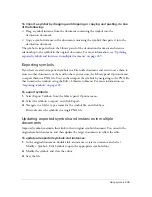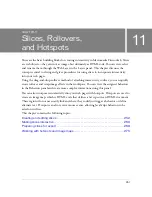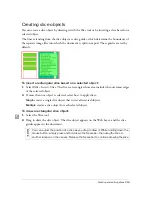
252 Chapter 11: Slices, Rollovers, and Hotspots
Creating and editing slices
Slicing cuts up a Fireworks document into smaller pieces and exports each piece as a separate
file. Upon export, Fireworks also creates an HTML file containing table code to reassemble
the graphic in a browser.
Slicing cuts a document into multiple pieces, which are exported as separate files.
Slicing an image has at least three major advantages:
Optimizing
One challenge of web graphic design is ensuring that images download quickly
without sacrificing quality. Slicing enables you to optimize each individual slice using the
most appropriate file format and compression settings. For more information, see
Chapter 14,
“Optimizing and Exporting,” on page 325
.
Interactivity
You can use slices to create areas that respond to mouse events. For
information on attaching interactivity to slices, see
“Making slices interactive” on page 260
.
Updating parts of a web page
Slicing allows you to easily update parts of a web page that
change frequently. For example, your company’s web page might have an employee-of-the-
month section that changes monthly. Slicing enables you to quickly change just the
employee’s name and photo without replacing the entire page.
Summary of Contents for FIREWORKS 8
Page 1: ...Using Fireworks...
Page 78: ...78 Chapter 3 Selecting and Transforming Objects...
Page 142: ...142 Chapter 5 Working with Vector Objects...
Page 166: ...166 Chapter 6 Using Text...
Page 192: ...192 Chapter 7 Applying Color Strokes and Fills...
Page 234: ...234 Chapter 9 Layers Masking and Blending...
Page 250: ...250 Chapter 10 Using Styles Symbols and URLs...
Page 324: ...324 Chapter 13 Creating Animation...
Page 372: ...372 Chapter 14 Optimizing and Exporting...
Page 444: ...444 Chapter 16 Automating Repetitive Tasks...
Page 454: ...454 Chapter 17 Preferences and Keyboard Shortcuts...
Page 472: ...472 Index...

